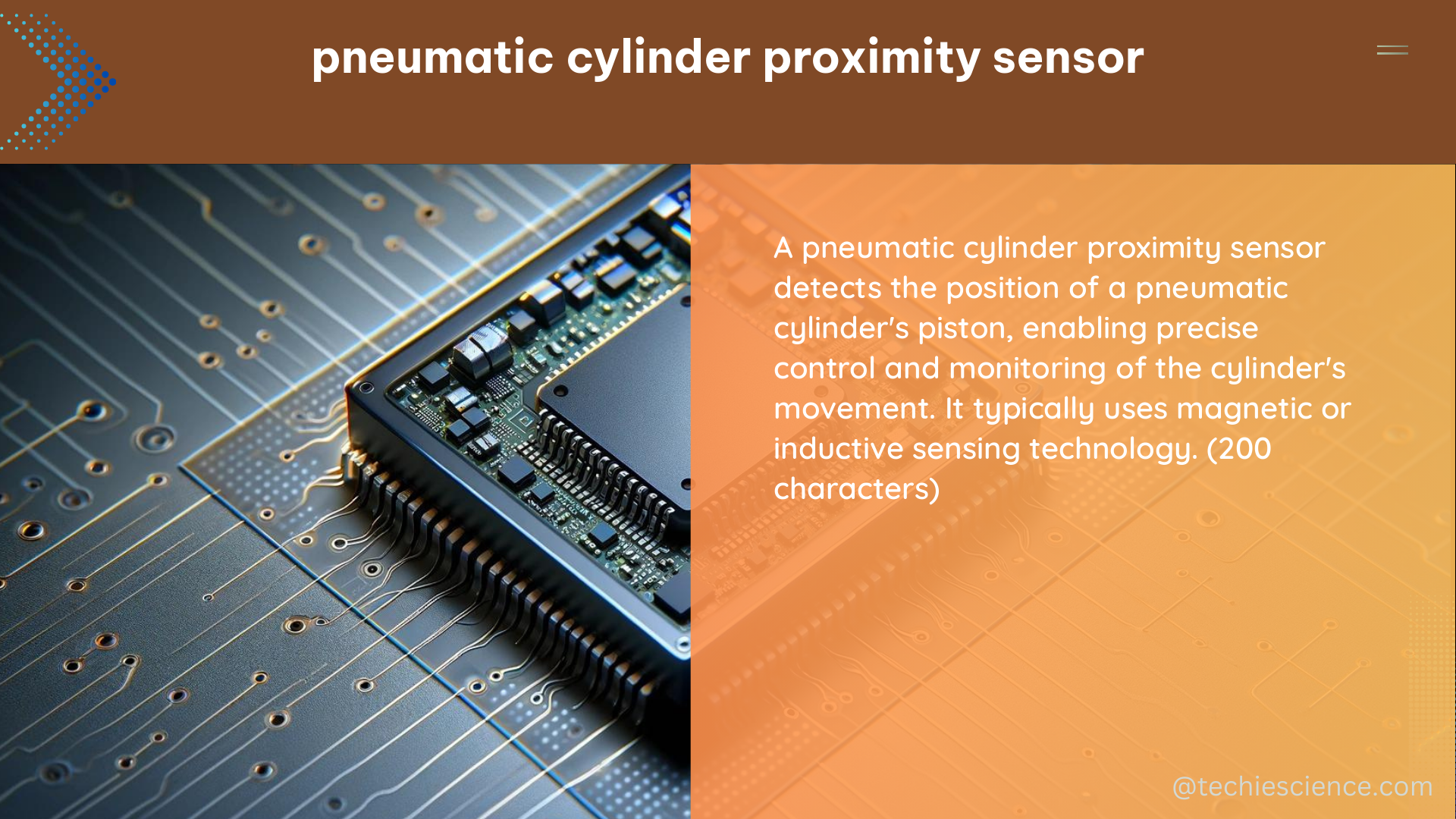Pneumatic cylinder proximity sensors are essential components in automation systems that utilize pneumatic cylinders. These sensors provide position feedback to control systems, enabling precise control and monitoring of pneumatic cylinder movement. The most common type of sensor used for pneumatic cylinders are magnetic proximity sensors, which detect the magnetic field of a magnet integrated in the cylinder piston.
Types of Magnetic Proximity Sensors
Magnetic proximity sensors come in various types, including reed sensors, AMR sensors, and GMR sensors.
Reed Sensors
Reed sensors are the most common and have been used for years due to their proven technology and long life cycle of over 10 million operations. However, they have concerns regarding life-time and shock/vibration, which can affect their performance. Reed sensors have a switching speed of 0.1 to 10 milliseconds, a mechanical robustness of 10 to 100 million cycles, and an electrical robustness of 10 to 100 million cycles. They can have double switch points, allowing for the detection of both the extended and retracted positions of the cylinder.
AMR Sensors
AMR sensors, on the other hand, have a more robust reaction to magnetic fields than reed sensors, at least 10%. They are also smaller, faster, and easier to integrate, making them a more reliable solution for detecting cylinder position. AMR sensors have a switching speed of 0.01 to 1 milliseconds, a mechanical robustness of 100 million to 1 billion cycles, and an electrical robustness of 100 million to 1 billion cycles. They do not have the capability for double switch points.
GMR Sensors
GMR sensors, the most up-to-date magnetic field sensing technology, have an even more robust reaction to magnetic fields than AMR sensors. They are also smaller, making them ideal for short-stroke cylinders, very small-bore cylinders, or miniature pneumatic grippers. GMR sensors have a switching speed of 0.001 to 0.1 milliseconds, a mechanical robustness of 1 billion to 10 billion cycles, and an electrical robustness of 1 billion to 10 billion cycles. Like AMR sensors, they do not have the capability for double switch points.
Mounting Methods for Pneumatic Cylinder Sensors

Pneumatic cylinder sensors can be mounted in different ways, depending on the body type of the cylinder.
Profile Cylinders
Profile cylinders, which are rectangular in shape, have two easy methods to mount sensors to the cylinder’s body. For pneumatic cylinders that adhere to ISO 15552, there are grooves along the body that make it easy to mount sensors. This method provides a secure and reliable mounting solution.
Round Cylinders
Round cylinders, on the other hand, have a different method of sensor mounting. These cylinders typically have a flat surface or a groove on the body, which allows for the mounting of sensors. The sensor is then secured in place using a clamp or a mounting bracket.
Technical Specifications of Pneumatic Cylinder Proximity Sensors
The technical specifications of pneumatic cylinder proximity sensors vary depending on the type of sensor.
| Specification | Reed Sensor | AMR Sensor | GMR Sensor |
|---|---|---|---|
| Switching Speed | 0.1 to 10 ms | 0.01 to 1 ms | 0.001 to 0.1 ms |
| Mechanical Robustness | 10 to 100 million cycles | 100 million to 1 billion cycles | 1 billion to 10 billion cycles |
| Electrical Robustness | 10 to 100 million cycles | 100 million to 1 billion cycles | 1 billion to 10 billion cycles |
| Double Switch Points | Yes or No | No | No |
It’s important to note that these specifications are general ranges, and the actual values may vary depending on the specific sensor model and manufacturer.
Factors to Consider when Selecting Pneumatic Cylinder Proximity Sensors
When selecting a pneumatic cylinder proximity sensor, there are several factors to consider:
- Cylinder Type: Determine the type of pneumatic cylinder (profile or round) and select a sensor that can be easily mounted on the cylinder body.
- Sensing Range: Ensure that the sensor’s sensing range is compatible with the stroke length of the pneumatic cylinder.
- Switching Speed: Choose a sensor with a switching speed that meets the requirements of your application, such as high-speed operation or precise positioning.
- Robustness: Consider the mechanical and electrical robustness of the sensor, especially if the application involves high levels of shock, vibration, or frequent switching.
- Double Switch Points: Determine if you need a sensor with the capability to detect both the extended and retracted positions of the cylinder.
- Environmental Factors: Ensure that the sensor is rated for the operating temperature, humidity, and other environmental conditions of your application.
- Compatibility: Verify that the sensor is compatible with the control system or PLC used in your automation system.
By carefully considering these factors, you can select the most appropriate pneumatic cylinder proximity sensor for your application, ensuring reliable and precise control of your pneumatic cylinder movements.
Conclusion
Pneumatic cylinder proximity sensors are critical components in automation systems that utilize pneumatic cylinders. Understanding the different types of magnetic proximity sensors, their mounting methods, and technical specifications is essential for selecting the right sensor for your application. By considering factors such as cylinder type, sensing range, switching speed, robustness, and environmental conditions, you can ensure that your pneumatic cylinder proximity sensor provides reliable and precise position feedback to your control system.
References:
- Pneumatic Cylinder – an overview | ScienceDirect Topics
- Pneumatic Cylinder Sensors – How They Work | Tameson.com
- Sensor Choices for Pneumatic Cylinder Positioning | Power & Motion

The lambdageeks.com Core SME Team is a group of experienced subject matter experts from diverse scientific and technical fields including Physics, Chemistry, Technology,Electronics & Electrical Engineering, Automotive, Mechanical Engineering. Our team collaborates to create high-quality, well-researched articles on a wide range of science and technology topics for the lambdageeks.com website.
All Our Senior SME are having more than 7 Years of experience in the respective fields . They are either Working Industry Professionals or assocaited With different Universities. Refer Our Authors Page to get to know About our Core SMEs.